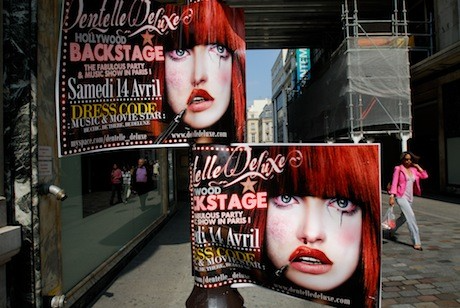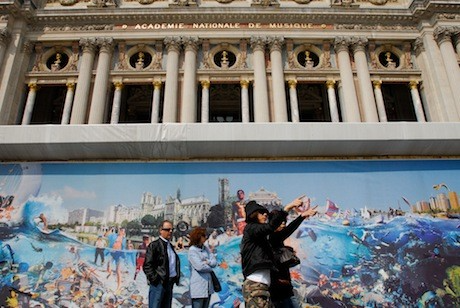Paris in 15 Shots

Tue 25 Oct 2011

David Bacher is an American photographer living in Paris and has a website that made us stop, look and listen. I wanted to get to know David a bit better, so I asked him to describe his version of Paris. Paris photos are ubiquitous and are often romantic in feel, but his tell a different story. He is the first male we’ve featured on our site, so I hope he considers himself lucky! In addition to his art photography, David also photographs weddings, fashion events and product launches. His view of Paris is that of someone who lives here and experiences the complexities of daily life in the capital.
David is an American Austrian photographer living near Paris. He was born in the United States and lived there until 1999. He attended the University of Virginia, where he earned a bachelor’s degree, with a double major in anthropology and economics. At the time, he was considering pursuing a career in international development, but he later decided that he wanted to follow his passion for photography and art. David moved to Vienna in 2000 and competed as a professional rower with the Austrian national team. In 2004 he was accepted into a six-month intensive course in photojournalism at the Danish School of Media and Journalism in Aarhus, Denmark. Following these studies, he moved to Paris and began work as an intern at VII Photo Agency, which specializes in conflict photography. Since then, David has decided to focus his work on less-dangerous subject matter, like people passing by in the streets of Paris. Well, this is not always the case, in fact.
David in his own words:
When I moved to Paris in 2004, I was single and had a good bit of free time to stroll around the streets. I found that walking was the best way to discover a new place. Thus, I simply began taking snapshots of what I saw in Paris. However, I knew that Paris had already been photographed a million times over by both tripists and very famous photographers like Henri-Cartier Bresson, Doisneau, Kertész, just to name a few. I therefore immediately tried to think of how I could portray the city somewhat differently than my predecessors.
For one thing, I photographed in color, which I prefer to black and white in general. Almost every postcard that you find in gift shops in Paris is in black and white. We see in color, so why not show it in photos? These same postcards also often show the clichés of Paris. My first prime example is the “kiss in front of the Paris town hall” by Doisneau. Not only is it a posed photo, and undoubtedly the most sold image of Paris, but it also portrays the idea that Paris is a city of love. Of course it is, or it can be, but not always. With this in mind, I started trying to capture moments in the streets of Paris that somehow contradicted how we imagined the city.
Since 2004 I’ve taken a good number of photos in Paris, and it’s difficult to exactly describe how they all fit together, but there are a few notions that run through the series. As previously mentioned, there is this notion of breaking down preconceived notions of the city that are often very cliché. I always try to capture fleeting moments and never ask people to pose in front of the camera. Finally, I like images that have tension, which can be either graphical or sociopolitical. In a graphic way, many of my photos tend to have layers, or various forms within the same frame. Sometimes one may see a photo within a photo. As the world is a complex place, I like taking complex photos.

1. I’m always drawn to things that just seem odd within a certain surrounding. That was the case with this sculpture in the Luxembourg Gardens. I wanted to show the contrast between the size of the sculpture and the small children coming up to look at it. This modern artwork also contradicts the notion of antiquity as shown by the ancient statues in the gardens.

2. As is the case in much of my work, I’m drawn to geometrical forms and the notion of good composition. If you are interested in knowing more about good composition I advise reading some of H-C Bresson’s essays. Again, this is a strange perspective, with the swimming instructor’s legs in the foreground and the swimmers doing water aerobics behind. There is a third level of onlookers behind. This was part of Paris Plages, and thus next to the Seine. Again, it’s quite odd to construct a pool right next to the river.

3. I liked this image for it’s purely graphical sense. I like the way the bodies are positioned in the image and the white line that cuts the photo in half. Again . . . composition. One also notices the contrast between the pretty young girls and the older Parisian woman. After taking a closer glance, you will notice “RATP” written on the one beach towel, which signifies the Paris metro system.

4. This was one of the first photos that I took in Paris, and in some ways it reminds me of a H-C Bresson photo in color. It is strong in a graphical sense, with the shadows cast on their backs and the one nun running across in the background. This definitely portrays the strong influence of the Catholic religion in France.

5. I like this photo because of the strong contrast between light and dark and the touch of red on the flower. With a closer look, you see the cross in the far back, on the upper left corner of the frame. Like many of these photos, we could read the image at several levels.

6. I find an odd contrast between the rather gruesome poster that is written in English and French, the piece of ugly scaffolding and the lady walking by dressed in pink.

7. This is one of the more editorial-type photos in the series, but I think it also gets at some of the more sociopolitical issues that arise in Paris. This was a transgender sex worker protesting a particular French law attempting to eradicate this trade in the city. I like the way the photo was taken from the top looking down, with only the feet of the police visible around the edges.

8. Again, this is one of my favorite photos, as it shows the Eiffel Tower in a way that most people are unaware of. The rings on the tower signify France’s presidency of the EU. The African man in the foreground is an illegal worker selling little miniature Eiffel Towers that light up, cigarette lighters, etc. How will the EU deal with illegal immigration in the future?

9. This is just a funny picture, and it’s very graphical in nature. Perhaps eating at McDonald’s will make one obese?

10. This photo shows a juxtaposition between the strip club sign in the background and the Muslim woman wearing a veil in the foreground. There are also many layers in this image, like the guy on the left looking down at people coming out of the metro, the lady reading the paper and the the picture of the surfer on the metro sign.

11. This image also focuses on the concept of immigration. The guy playing the trumpet is a gypsy, and the sign says, Destroy that which destroys us.

12. This is another sociopolitical photo of the Eiffel Tower. My first thought is China’s economic supremacy over France and the rest of the world.

13. I took this picture when the Paris opera house was being renovated. The funny poster covering up the work area contrasts with the old columns on the front of the opera. A few tripists somehow seem to be part of the complex poster.

14. This is definitely one of my favorite wedding photos. This couple was from Canada, and they came to Paris to have their romantic dream wedding. I photographed their wedding, and then went around Paris with them, taking pictures at various locations. We were actually just taking a rest at this café, which is located right next to the Paris art academy, and I noticed that this could turn into a very unique photo. I merely waited in front of the couple, hunched down, for things to happen in the background. This is the great thing about working with wide-angle lenses. You can capture a lot in one frame, without many subjects knowing that they are being photographed.

15. This is another one of those funny moments that appear when you least expect it. I noticed the two dogs leashed up to the old door and liked the visual contrast with the storefront of the pharmacy. This was the graphical base of the image. Then the old lady who owned the dogs came out and didn’t really know how to react, because I was pointing my camera toward her. I got two or three frames, and this was the best one.
Related Links
David Bacher
David Bacher Photos de Mariage
David Bacher’s blog